

*Games and Education Scholar James Paul Gee on Video Games, Learning, and Literacy. *Five Psychological Principles Fueling Gamification : Learning Solutions Magazine. *Keynote - Thinking Inside the Box: The Changing Landscape of Learning with Adam Bellow Adam Bellow. *Jane McGonigal on the Neuroscience of Play. *Find the Learning in Any Game. *Harris Keynote from AASL GAME 2016. *Jennifer's BreakoutEDU Website. *Play Play Learn. Games in Libraries: Essays on Using Play to Connect and Instruct (Scan book) John Seely Brown. Level Up Learning: A National Survey on Teaching with Digital Games. How To Use Social Learning And Epic Meaning To Succeed With Gamification - eLearning Industry. ABC OF GAMIFICATION – ED Blog.
Knowledge Sharing Gone are the days of going through hours of learning content sitting back-to-back on your desktop.

Today, you can quickly learn on your smart phone while travelling to work. Introduction of gamification in the learning environment adds to the engagement and overall experience. Game-based learning designed for a global environment conservation organization Why do we need gamification? Increase level of engagement:Think of this situation, you need to complete a five-hour- long digital content in the next two days as it is your primary KPA. The energy consumption cycle explained in the game. Breakout EDU Brings “Escape Room” Strategy to the Classroom. A class about to open their locked Breakout EDU box during a game.
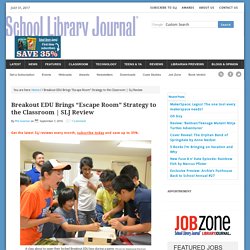
Photo by Stephanie Harman Escape rooms have been popping up all over the country. That’s where a group of people are willingly locked in and given an hour to “break out.” They follow clues posted or hidden in the room, sidestep the red herrings, and work together to beat the clock. Library Escape Rooms (Patti Dallas Johnson's Pinterest board) TPiB: Locked in the Library! Hosting an escape room program at your library. Puzzles, mystery, a darkened library, a time limit, and the ominous feeling that a ghost just might be looking over your shoulder?

Yes, please! My library is this gorgeous 80+ year old building that’s been expanded thoughtfully so that the original building–a one-room stone space with tall windows, a fireplace, and impressive oak doors–has been preserved as a reading room. It’s not a place teens have much opportunity to enjoy unless they’re quietly studying for finals all alone. It’s quiet. It gets dark. It becomes an ideal spot to try out a locked room/escape room program.
Educational Escape Rooms Engage Students with Innovative Puzzles and Tasks - The Atlantic. Shauna Pollock, a Toronto-based educator and the author of Creating Classroom Magic, a book about using the Disney-inspired principles of magic, safety, and courtesy in teaching, believes educational escape rooms have enormous potential to be effective in schools, since they can be adapted to any subject.
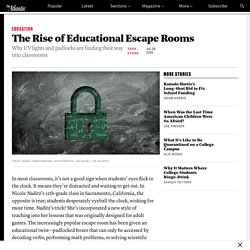
“[They can] excite learners and help develop their skills, teaching them content through immersive, engaging play,” she wrote in a recent paper. This style of puzzle-based learning is well suited for web-based games, which also provide access to a larger audience. In 2012, Arizona State University trialed this by building Science Detectives: Training Room Escape, a click-through online escape room for preK-12 learners.
“Instead of the typical lecture, we wanted the student to have fun playing a game that just so happens to require using the Scientific Method to succeed,” said Charles Kazilek, the chief technology officer at Arizona State University. Library Media Tech Talk: Library Orientation Breakout EDU. Planning (Kaitlyn & Stony) We actually started talking about this potential early in August.
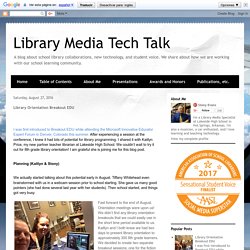
Tiffany Whitehead even brainstormed with us in a webcam session prior to school starting. She gave us many good pointers (she had done several last year with her students). Then school started, and things got very busy. Fast forward to the end of August. The Event (Kaitlyn & Stony) Disruptive technology: Gamification. The ILN has looked at games in libraries in a previous discussion topic in 2015.

More specifically though, gamification, “the use of game mechanics and experience design to digitally engage and motivate people to achieve their goals” (Burke, 2014), is being used in libraries to disrupt the customary orientation programs, and the usual methods of teaching information literacy. This post will look into the specifics of game elements, and some programs that can be used to build these gamified programs. Game elements/mechanics Dan Hunter recently spoke at the Australian Law Librarians Association (ALLA) conference on exactly this topic.
Developing Literacy Skills with Video Games in Education. Games in education are nothing new.
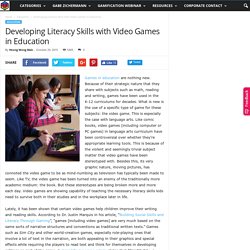
Because of their strategic nature that they share with subjects such as math, reading and writing, games have been used in the K-12 curriculums for decades. What is new is the use of a specific type of game for these subjects: the video game. This is especially the case with language arts. Game-Based or Playful Learning, not Gamification for All Things. 3 Ways to Use Game-Based Learning. What exactly is game-based learning, anyway? Is it a roomful of children playing video games? Is it students designing games? Or is it both of these? Good games—as opposed to candy-coated, multiple-choice quiz games—provide immersive experiences for students.
Like novels, films, plays, and other media, games can be high-quality materials a teacher uses to enable students to access the curriculum. Will virtual and augmented reality move us into the knowledge age? 12 Surprising Things Your Child Can Learn from Minecraft. Video gaming has been seen by some detractors as a passive, mind-numbing activity that has an adverse effect on children’s social development.

In fact, research indicates the exact opposite. There are a number of benefits to playing video games, including cognitive development, motor skill development, and creative problem solving. How virtual reality technology is changing the way students learn. For many years, schools and universities have had to change the way they work and teach in order to fit in with technology.
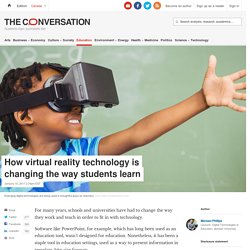
Software like PowerPoint, for example, which has long been used as an education tool, wasn’t designed for education. Nonetheless, it has been a staple tool in education settings, used as a way to present information in template, bite-size formats. But this isn’t always a good thing. The use of digital technologies sees some teachers and students presenting information using templates, which means much of the individual character of teachers’ practices can be lost. Play as an approach – It Happened in the Library. Play is not so much an activity as it is an approach.

It is a very particular, instinctual, joyous approach towards interacting with our environment and each other. It is not something that only children do. Our play oriented activities may change as we progress through life, but the instinct towards play as a style of engagement with our world and each other, remains. Sure… some of us may have lost the spontaneity we had as children. AR, VR Lead Top Tech Trends Discussion. Augmented reality (AR) technology is not new, but the growing ubiquity of smartphones is making it possible for libraries and other cultural institutions to create new applications that allow patrons to explore collections in new and exciting ways, Cynthia Hart, emerging technologies librarian, Virginia Beach Public Library, explained during the Library Information Technology Association’s (LITA) Top Tech Trends panel on January 22 at the American Library Association’s Annual Midwinter conference in Atlanta. AR can be traced back to heads up displays used in airplanes in the 1950s, and mainstream use has been growing since the 2000 release of Hirokazu Kato’s open source ARToolKit, which enables the overlay of computer generated imagery on video, Hart noted.
Use Classic Games to Ignite Student Engagement. As a new middle school media specialist in a school that serves students in grades 5 through 8, I spent most of last year collaborating with Sara, our school's instructional technology facilitator. We focused on converting our media center from a traditional library model into a learning commons model. This model updates the library from a storehouse of information to a place where students can interact with information, learn 21st-century skills, and create content and materials in a whole new way. Our language arts, social studies, and science teachers were quick to see the value in our new learning commons. But many math teachers didn't see the relevance to their subject area. Overcoming 10 Common Obstacles of Game-Based Teaching. Game-based teaching is an exciting adventure for any teacher to embark on with their students. It excites learners and connects them to the curriculum in ways they can appreciate and be attentive to.
Unfortunately, like many instructional approaches with a strong technology foundation, there can be difficulties. But with every challenge comes an opportunity to grow and excel. In the MindShift article Games in the Classroom: Overcoming the Obstacles, Jordan Shapiro gives us some sage advice on surmounting 10 of the most frequent obstacles faced by teachers adopting game-based learning strategies.
The obstacles Shapiro guides us over were taken from a survey of 700 teachers conducted by the Games and Learning Publishing Council. Here then is a summary of the challenges presented by game-based teaching and Shapiro’s suggested strategies for turning them around. 1. 2. Game-Based Learning: Resource Roundup. Digital Technologies Hub. Level F - 2: Follow, describe and represent a sequence of steps and decisions (algorithims) needed to solve simple problems (ACTDIP004) Level 3 - 4:
Extra Credits. Board Games in the Library – Teen Services Underground. When the average person thinks of board games, they likely think of games like Sorry, Monopoly, and Risk. While Risk certainly has some strategic elements, and it could be argued that Monopoly has a few as well, the central theme of these games is luck. Playing games at the Library: Seriously? 1. Introduction. Epic Guide To Game Based Learning.
Games are fun. Where History Comes Alive: Augmented Reality in Museums. The game-player’s hat (Barbara Braxton) As the cooler days of Australia’s winter encroach, more and more students make their way to the library as a warm haven during recess and lunch breaks. PD Series: Gamification of Information Literacy Learning. Foundations of Game-Based Learning (EJ1090277) CENZ presents Bron Stuckey. Games in Libraries – brought to you by ALA GameRT.